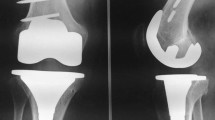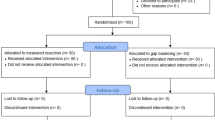Abstract
Purpose
The measured resection technique and the gap-balancing technique are two philosophies used in total knee surgery. It is still unknown whether one or the other technique provides superior results when computer-assisted surgery is performed. We hypothesized that the gap-balancing technique improves joint stability because the technique relies primarily on the soft tissue.
Methods
A prospective controlled study was performed in 116 patients using the tibia-first or femur-first technique. The ColumbusTM total knee system and the Orthopilot® (Aesculap® AG, Tuttlingen, Germany) navigation system were used in all cases. Sixty-three patients were allocated to the femur-first technique (group F) and 53 patients to the tibial first technique (group T). The mean follow-up time was 11.4 ± 1.1 months. The KSS, KOOS and SF-36 were taken prior to surgery and at the time of follow-up for clinical assessment. Long-leg weight-bearing radiographs were performed to assess ligament alignment. Radiographs in varus and valgus stress were performed using the Telos®-Instrument (Telos® GmbH, Greisheim, Germany) under a force of 15 N at the time of follow-up for the assessment of medial–lateral stability. The nonparametric t test (Mann–Whitney U-test) was used in order to compare the ligament stability and the scores between group F and group T.
Results
The lateral joint space opening for groups F and T was 3.4° ± 1.4° and 3.9° ± 1.7°, respectively (n.s.), and the medial joint space opening for groups F and T was 4° ± 1.4° and 4.1° ± 1.7°, respectively (n.s.). The femorotibial mechanical axis for groups F and T revealed 1.4° ± 1.2° and 0.7° ± 2.0° of varus, respectively (p = 0.138). The clinical assessment showed significant improvement according to KSS, KOOS and SF-36 in all subscales. Neither of the sores showed significant differences between the two groups.
Conclusion
The surgeon should use his/her preferred surgical technique providing the implantation is performed with computer assistance. It remains unclear whether the same findings will occur after conventional surgery.
Level of evidence
II.



Similar content being viewed by others
References
Anderson KC, Buehler KC, Markel DC (2005) Computer assisted navigation in total knee arthroplasty comparison with conventional methods. J Arthroplast 20:132–138
Bäthis H, Perlick L, Tingart M, Perlick C, Lüring C, Grifka J (2005) Intraoperative cutting errors in total knee arthroplasty. Arch Orthop Trauma Surg 125:16–20
Becker R, Döring C, Denecke A, Brosz M (2011) Expectation, satisfaction and clinical outcome of patients after total knee arthroplasty. Knee Surg Sports Traumatol Arthrosc 19:1433–1441
Bellemans J, D’Hooghe P, Vandenneucker H, Van Damme G, Victor J (2006) Soft tissue balance in total knee arthroplasty: does stress relaxation occur perioperatively? Clin Orthop Relat Res 452:49–52
Bellemans J, Robijns F, Duerinckx J, Banks S, Vandenneucker H (2005) The influence of tibial slope on maximal flexion after total knee arthroplasty. Knee Surg Sports Traumatol Arthrosc 13:193–196
Brazier JE, Harper R, Jones NM, O’Cathain A, Thomas KJ, Usherwood T, Westlake L (1992) Validating the SF-36 health survey questionnaire: new outcome measure for primary care. BMJ 305:160–164
Bullinger M, Alonso J, Apolone G, Leplège A, Sullivan M, Wood-Dauphinee S, Gandek B, Wagner A, Aaronson N, Bech P, Fukuhara S, Kaasa S, Ware JE (1998) Translating health status questionnaires and evaluating their quality: the IQOLA Project approach. International Quality of Life Assessment. J Clin Epidemiol 51:913–923
Catani F, Biasca N, Ensini A, Leardini A, Bianchi L, Digennaro V, Giannini S (2008) Alignment deviation between bone resection and final implant positioning in computer-navigated total knee arthroplasty. J Bone Jt Surg Am 90:765–771
Crottet D, Kowal J, Sarfert SA, Maeder T, Bleuler H, Nolte LP, Dürselen L (2007) Ligament balancing in TKA: evaluation of a force-sensing device and the influence of patellar eversion and ligament release. J Biomech 40:1709–1715
Fehring TK, Odum S, Griffin WL, Mason JB, Nadaud M (2001) Early failures in total knee arthroplasty. Clin Orthop Relat Res 392:315–318
Hepinstall MS, Rutledge JR, Bornstein LJ, Mazumdar M, Westrich GH (2011) Factors that impact expectations before total knee arthroplasty. J Arthroplast 26:870–876
Hofmann AA, Kurtin SM, Lyons S, Tanner AM, Bolognesi MP (2006) Clinical and radiographic analysis of accurate restoration of the joint line in revision total knee arthroplasty. J Arthroplast 21:1154–1162
Insall JN, Dorr LD, Scott RD, Scott WN (1989) Rationale of the Knee Society clinical rating system. Clin Orthop Relat Res 248:13–14
Kiebzak GM, Campbell M, Mauerhan DR (2002) The SF-36 general health status survey documents the burden of osteoarthritis and the benefits of total joint arthroplasty: but why should we use it? Am J Manag Care 8:463–474
Kuster MS, Jeffcote BO, Schirm AC, Jacob H, Nicholls RL (2009) Assessment of isometricity before and after total knee arthroplasty: a cadaver study. Knee 16:352–357
Lee DH, Park JH, Song DI, Padhy D, Jeong WK, Han SB (2010) Accuracy of soft tissue balancing in TKA: comparison between navigation-assisted gap balancing and conventional measured resection. Knee Surg Sports Traumatol Arthrosc 18:381–387
Lehnen K, Giesinger K, Warschkow R, Porter M, Koch E, Kuster MS (2011) Clinical outcome using a ligament referencing technique in CAS versus conventional technique. Knee Surg Sports Traumatol Arthrosc 19:887–892
Mason JB, Fehring TK, Estok R, Banel D, Fahrbach K (2007) Meta-analysis of alignment outcomes in computer-assisted total knee arthroplasty surgery. J Arthroplast 22:1097–1106
Milner CE (2009) Is gait normal after total knee arthroplasty? Systematic review of the literature. J Orthop Sci 14:114–120
Mulhall KJ, Ghomrawi HM, Scully S, Callaghan JJ, Saleh KJ (2006) Current etiologies and modes of failure in total knee arthroplasty revision. Clin Orthop Relat Res 446:45–50
Pang HN, Yeo SJ, Chong HC, Chin PL, Ong J, Lo NN (2011) Computer-assisted gap balancing technique improves outcome in total knee arthroplasty, compared with conventional measured resection technique. Knee Surg Sports Traumatol Arthrosc 19:1496–1503
Roos EM, Roos HP, Ekdahl C, Lohmander LS (1998) Knee injury and Osteoarthritis Outcome Score (KOOS)-validation of a Swedish version. Scand J Med Sci Sports 8:439–448
Samson AJ, Mercer GE, Campbell DG (2010) Total knee replacement in the morbidly obese: a literature review. ANZ J Surg 80:595–599
Selvarajah E, Hooper G (2009) Restoration of the joint line in total knee arthroplasty. J Arthroplast 24:1099–1102
Taylor WR, Heller MO, Bergmann G, Duda GN (2004) Tibio-femoral loading during human gait and stair climbing. J Orthop Res 22:625–632
Tigani D, Sabbioni G, Ben Ayad R, Filanti M, Rani N, Del Piccolo N (2010) Comparison between two computer-assisted total knee arthroplasty: gap-balancing versus measured resection technique. Knee Surg Sports Traumatol Arthrosc 18:1304–1310
Tingart M, Lüring C, Bäthis H, Beckmann J, Grifka J, Perlick L (2008) Computer-assisted total knee arthroplasty versus the conventional technique: how precise is navigation in clinical routine? Knee Surg Sports Traumatol Arthrosc 16:44–50
Victor J, Bellemans J (2006) Physiologic kinematics as a concept for better flexion in TKA. Clin Orthop Relat Res 452:53–58
Victor J, Wong P, Witvrouw E, Sloten JV, Bellemans J (2009) How isometric are the medial patellofemoral, superficial medial collateral, and lateral collateral ligaments of the knee? Am J Sports Med 37:2028–2036
Yau WP, Chiu KY (2008) Cutting errors in total knee replacement: assessment by computer assisted surgery. Knee Surg Sports Traumatol Arthrosc 16:670–673
Acknowledgments
We thank Viktor Breul and Aesculap AG for programming and statistical analysis.
Author information
Authors and Affiliations
Corresponding author
Rights and permissions
About this article
Cite this article
Becker, R., Malzdorf, M., Stärke, C. et al. No difference between tibia-first and femur-first techniques in TKA using computer-assisted surgery. Knee Surg Sports Traumatol Arthrosc 20, 2011–2016 (2012). https://doi.org/10.1007/s00167-012-1928-3
Received:
Accepted:
Published:
Issue Date:
DOI: https://doi.org/10.1007/s00167-012-1928-3




